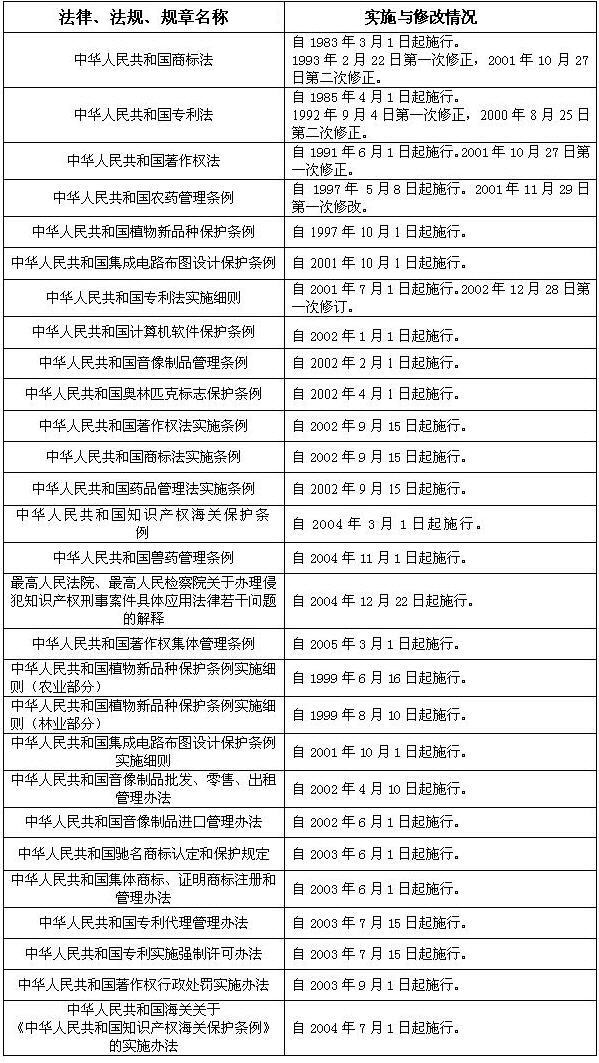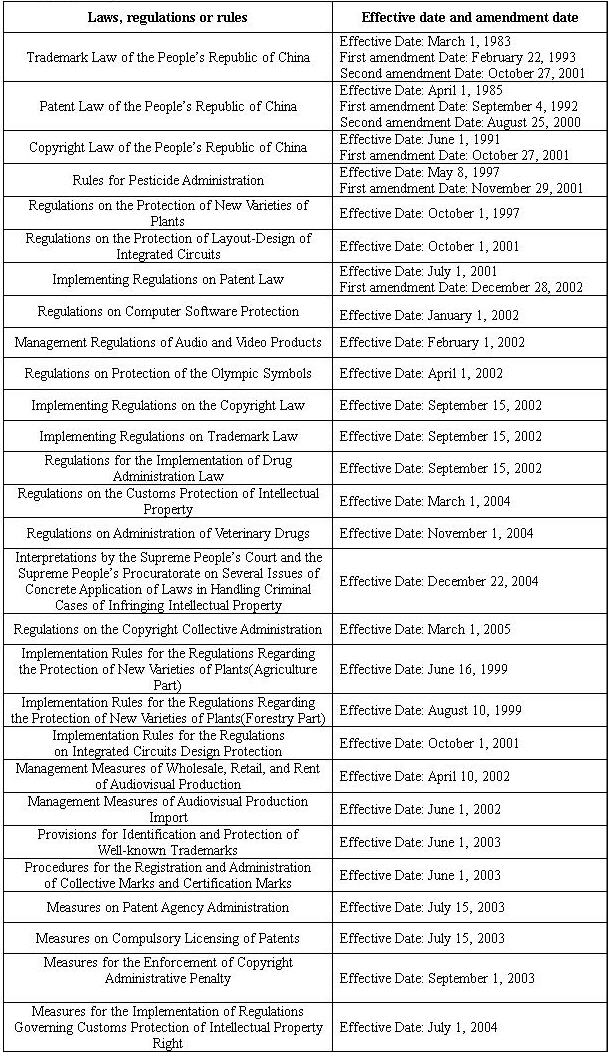我司从今天起,刊登该文的第一部分:中国知识产权立法状况(中英文)。在今后的一段时间里,我司将陆续刊登该文的其他部分,敬请关注!
《中国知识产权保护》之一:中国知识产权立法状况
20世纪80年代,在改革开放的初期,中国就开始了知识产权保护的法制建设。为了适应经济发展和科技进步的要求,根据中国国民经济发展的客观需要,通过借鉴国际公约、条约规定和其他国家在知识产权保护立法方面的先进经验,中国不断建立健全了知识产权保护的立法体系。中国现有的知识产权保护法律体系主要由法律、行政法规和部门规章三个部分组成。其中,专门法律主要包括《商标法》、《专利法》、《著作权法》等;专门行政法规包括《商标法实施条例》、《专利法实施细则》、《著作权法实施条例》、《知识产权海关保护条例》、《计算机软件保护条例》、《集成电路布图设计保护条例》、《植物新品种保护条例》等;专门部门规章包括《驰名商标认定和保护规定》、《集体商标、证明商标注册和管理办法》、《专利实施强制许可办法》等(各主要专门知识产权法律、行政法规和部门规章的颁布与修改的具体情况见下文表1)。此外,中国的民法、刑法、对外贸易法以及最高人民法院和最高人民检察院发布的有关司法解释中也包括了知识产权保护的专门规定。总之,中国已经建立了比较健全的知识产权保护法律体系,这已经得到了世界各国及国际组织的普遍认可。
在不断建立健全知识产权法律体系的同时,中国也根据实际需要对相关法律法规进行了修改。特别是在加入世界贸易组织的过程中,为履行入世承诺,中国政府严格遵循世界贸易组织《与贸易有关的知识产权协定》(TRIPS)的有关规定对国内知识产权立法进行了修改和完善。修改后的法律法规扩大了权利保护的范围,增强了对权利人的保护力度和司法审查的有关内容,从而完善了中国的知识产权保护法律制度,使中国的知识产权保护法律同TRIPS的规定完全一致。如修改后的《中华人民共和国商标法》及其实施条例扩大了可作为商标保护的客体范围,专门规定了对地理标识和驰名商标的保护,增加了关于优先权的规定,增加了对商标确权的行政裁决的司法审查,加强了对侵权行为的查处力度;修改后的《中华人民共和国专利法》及其实施细则将专利的保护客体扩大到药品、食品及通过化学手段获得的物质等,延长了专利的保护期限,完善了授予专利强制许可的条件,增加了对外观设计、实用新型专利的行政裁决的司法审查;修改后的《中华人民共和国著作权法》及其实施条例增加了受保护权利的种类,明确界定了表演者和制作者的权利,增加了关于财产保全和证据保全临时措施的规定,增加了关于法定赔偿额的规定,加重了对损害社会公共利益的侵权行为的行政处罚。修改后的《中华人民共和国专利法》、《中华人民共和国商标法》、《中华人民共和国著作权法》等还增加了诉前责令停止有关行为的临时禁令,增强了对权利人的保护力度。这些法律法规的修改都进一步完善了中国知识产权保护的法律体系。
此外,中国还在不断积极研究制定有关知识产权保护的新法律、新法规,如自2004年12月22日起施行的《最高人民法院、最高人民检察院关于办理侵犯知识产权刑事案件具体应用法律若干问题的解释》,于2005年3月1日开始实施的《著作权集体管理条例》以及目前正在研究制定的《信息网络传播权保护条例》等。相信随着这些新法律法规的出台,中国的知识产权保护法律体系会进一步得到健全与完善,中国的知识产权保护法制建设也会不断向前发展。
表1:中国现行主要知识产权法律、行政法规、部门规章一览表

Ι. Status Regarding Legislation in Terms of IPR in China
In the early period of the reform and opening up to the outside world in the 1980s, China began its legislation regarding the protection of intellectual property (IP). In order to meet the requirements of economic development and scientific advancement and to satisfy the objective needs in developing the national economy, China has used for reference the relevant international conventions, treaties and the strong points of other countries’ legislation in this aspect, gradually established and improved its legal system in terms of the protection of IPR. Our present legal system in this regard mainly comprises the following three parts: laws, administrative regulations and department rules. These laws mainly include: Trademark Law of the People’s Republic of China, Patent Law of the People’s Republic of China, Copyright Law of the People’s Republic of China, and so on. Special administrative regulations include: Implementing Regulations on Trademark Law of the People’s Republic of China, Implementing Regulations on Patent Law of the People’s Republic of China, Implementing Regulations on Copyright Law of the People’s Republic of China, Regulations of the People's Republic of China on the Customs Protection of Intellectual Property, Regulations on Computer Software Protection, Regulations for the Protection of Layout-Design of Integrated Circuits, Regulations on the Protection of New Varieties of Plants, and so on. Special department rules include: Provisions for Identification and Protection of Well-known Trademarks, Procedures for the Registration and Administration of Collective Marks and Certification Marks, Measures on Compulsory Licensing of Patents, and so on (for details about the promulgation and amendment of some of those main specific laws, administrative regulations, and department rules on intellectual property, please refer to Table 1 below). In addition, some of China’s civil laws, criminal laws, foreign trade laws and judicial interpretations issued by the Supreme People’s Court or the Supreme People’s Procuratorate also include special regulations about IPR protection. In conclusion, China has established a relatively sound legal system concerning IPR, which has won universal acknowledgment from the other countries across the world as well as the international organizations.
During the process of building up its legal system in terms of IPR, China has made amendments regarding some concerned laws, regulations and rules with a view to satisfying the requirements arising from reality. For example, when making preparations for joining WTO, the Chinese government made necessary amendments and improvement regarding its legal system about IPR according to the requirements of Agreement on the Trade-Related Aspects of Intellectual Property Rights (TRIPS) of WTO, in order to fulfill its commitment for joining the Organization. The amended laws, regulations and rules provide a wider protection scope and stronger protection for the owner of IPR and they put more emphasis on judicial reviews. These amendments have greatly improved Chinese legal system in terms of IPR, thus ensuring its consistency with the TRIPS. For instance, the amended Trademark Law of the People’s Republic of China and its implementing regulations have extended their protection scope so that more objects can be protected as trademarks. They contain special provisions for the protection of geographical indications and well-known trademarks, add regulations concerning the right of priority, and judicial reviews over administrative determinations on trademarks, and also strengthen the investigation and punishment against infringement. The amended Patent Law of the People’s Republic of China and its implementing regulations have enlarged the scope of objects enjoying patent protection to medicine, food and substances obtained chemically. They prolong the protection term of patents, perfect requirements for the award of compulsory patent license and strengthen judicial reviews over administrative determinations on patent for a design and utility model. The amended Copyright Law of the People’s Republic of China and its implementing regulations have extended the types of rights to be protected. They clarify the rights of performers and producers, add the provisional measures as property attachment and preservation of evidence, and provisions about statutory damages, and increase administrative punishment against infringements harming the public interests. These three amended laws also include temporary injunctions prohibiting an action by a party before a lawsuit and provide stronger protection for the owner of IPR. All these amendments have greatly improved Chinese legal system regarding IPR protection.
Moreover, China has never stopped its work on new laws and regulations for IPR protection. For example, Interpretations by the Supreme People’s Court and the Supreme People’s Procuratorate on Several Issues of Concrete Application of Laws in Handling Criminal Cases of Infringing Intellectual Property went into effect on Dec. 22, 2004, while the Regulations for the Collective Administration of Copyright have become effective on Mar. 1, 2005. In addition, Regulations on the Right of Communication through Information Network are also under discussion at the present time. It is believed that with the promulgation of these new laws and regulations, China’s legal system regarding IPR will be further improved and perfected, and China’s legislation in this regard will gain continuous development.
Table 1: List of China’s Current Main Laws, Administrative Regulations and Department Rules Regarding Intellectual Property Rights

(信息来源:条法司子站)



